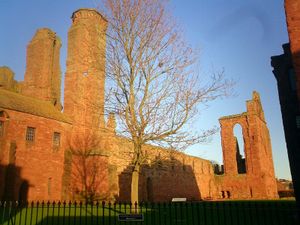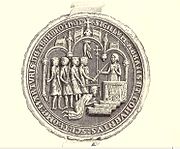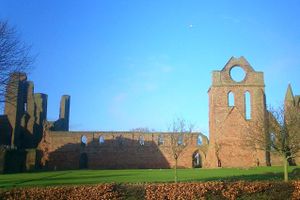
Arbroath Abbey
Encyclopedia

Arbroath
Arbroath or Aberbrothock is a former royal burgh and the largest town in the council area of Angus in Scotland, and has a population of 22,785...
, was founded in 1178 by King William the Lion
William I of Scotland
William the Lion , sometimes styled William I, also known by the nickname Garbh, "the Rough", reigned as King of the Scots from 1165 to 1214...
for a group of Tironensian
Tironensian
The Tironensian Order or the Order of Tiron was a Roman Catholic monastic order named after the location of the mother abbey in the woods of Tiron in Perche, some 35 miles west of Chartres in France)...
Benedictine
Benedictine
Benedictine refers to the spirituality and consecrated life in accordance with the Rule of St Benedict, written by Benedict of Nursia in the sixth century for the cenobitic communities he founded in central Italy. The most notable of these is Monte Cassino, the first monastery founded by Benedict...
monks from Kelso Abbey
Kelso Abbey
Kelso Abbey is what remains of a Scottish abbey founded in the 12th century by a community of Tironensian monks first brought to Scotland in the reign of Alexander I. It occupies ground overlooking the confluence of the Tweed and Teviot waters, the site of what was once the Royal Burgh of Roxburgh...
. It was consecrated
Consecration
Consecration is the solemn dedication to a special purpose or service, usually religious. The word "consecration" literally means "to associate with the sacred". Persons, places, or things can be consecrated, and the term is used in various ways by different groups...
in 1197 with a dedication to the deceased Saint Thomas Becket
Thomas Becket
Thomas Becket was Archbishop of Canterbury from 1162 until his murder in 1170. He is venerated as a saint and martyr by both the Roman Catholic Church and the Anglican Communion...
, whom the king had met at the English
England
England is a country that is part of the United Kingdom. It shares land borders with Scotland to the north and Wales to the west; the Irish Sea is to the north west, the Celtic Sea to the south west, with the North Sea to the east and the English Channel to the south separating it from continental...
court. It was William's only personal foundation — he was buried before the high altar of the church in 1214.
The last Abbot was Cardinal
Cardinal (Catholicism)
A cardinal is a senior ecclesiastical official, usually an ordained bishop, and ecclesiastical prince of the Catholic Church. They are collectively known as the College of Cardinals, which as a body elects a new pope. The duties of the cardinals include attending the meetings of the College and...
David Beaton
David Beaton
The Most Rev. Dr. David Cardinal Beaton was Archbishop of St Andrews and the last Scottish Cardinal prior to the Reformation.-Career:...
, who in 1522 succeeded his uncle James to become Archbishop of St Andrews
St Andrews
St Andrews is a university town and former royal burgh on the east coast of Fife in Scotland. The town is named after Saint Andrew the Apostle.St Andrews has a population of 16,680, making this the fifth largest settlement in Fife....
. The Abbey is cared for by Historic Scotland
Historic Scotland
Historic Scotland is an executive agency of the Scottish Government, responsible for historic monuments in Scotland.-Role:As its website states:...
and is open to the public throughout the year (entrance charge). The distinctive red sandstone
Sandstone
Sandstone is a sedimentary rock composed mainly of sand-sized minerals or rock grains.Most sandstone is composed of quartz and/or feldspar because these are the most common minerals in the Earth's crust. Like sand, sandstone may be any colour, but the most common colours are tan, brown, yellow,...
ruins stand at the top of the High Street in Arbroath.
History

Mother Church
In Christianity, the term mother church or Mother Church may have one of the following meanings:# The first mission church in an area, or a pioneer cathedral# A basilica or cathedral# The main chapel of a province of a religious order...
and endowed it generously, including income from 24 parishes, land in every royal burgh and more. The Abbey's monks were allowed to run a market and build a harbour. King John of England
John of England
John , also known as John Lackland , was King of England from 6 April 1199 until his death...
gave the Abbey permission to buy and sell goods anywhere in England
England
England is a country that is part of the United Kingdom. It shares land borders with Scotland to the north and Wales to the west; the Irish Sea is to the north west, the Celtic Sea to the south west, with the North Sea to the east and the English Channel to the south separating it from continental...
(except London
London
London is the capital city of :England and the :United Kingdom, the largest metropolitan area in the United Kingdom, and the largest urban zone in the European Union by most measures. Located on the River Thames, London has been a major settlement for two millennia, its history going back to its...
) toll-free.
The Abbey, which was the richest in Scotland
Scotland
Scotland is a country that is part of the United Kingdom. Occupying the northern third of the island of Great Britain, it shares a border with England to the south and is bounded by the North Sea to the east, the Atlantic Ocean to the north and west, and the North Channel and Irish Sea to the...
, is most famous for its association with the 1320 Declaration of Arbroath
Declaration of Arbroath
The Declaration of Arbroath is a declaration of Scottish independence, made in 1320. It is in the form of a letter submitted to Pope John XXII, dated 6 April 1320, intended to confirm Scotland's status as an independent, sovereign state and defending Scotland's right to use military action when...
, believed to have been drafted by Abbot Bernard
Bernard of Kilwinning
Bernard was a Tironensian abbot, administrator and bishop active in late 13th- and early 14th-century Scotland, during the First War of Scottish Independence...
, who was the Chancellor of Scotland under King Robert I
Robert I of Scotland
Robert I , popularly known as Robert the Bruce , was King of Scots from March 25, 1306, until his death in 1329.His paternal ancestors were of Scoto-Norman heritage , and...
.
Since 1947, a major historical re-enactment commemorating the Declaration's signing has been held within the roofless remains of the Abbey church. The celebration and many other events are now run by the Arbroath Abbey Timethemes a local charity, and tells the story of the events which led up to the signing. This is not an annual event; the most recent performances have been in August 2000 and 2005 but more are planned. However, a special event to mark the signing is held every year on the 6th of April and involves a street procession and short piece of street theatre.
The Abbey fell into ruin after the Reformation
Scottish Reformation
The Scottish Reformation was Scotland's formal break with the Papacy in 1560, and the events surrounding this. It was part of the wider European Protestant Reformation; and in Scotland's case culminated ecclesiastically in the re-establishment of the church along Reformed lines, and politically in...
. From 1590 onward, its stones were raided for buildings in the town of Arbroath
Arbroath
Arbroath or Aberbrothock is a former royal burgh and the largest town in the council area of Angus in Scotland, and has a population of 22,785...
. This continued until 1815 when steps were taken to preserve the remaining ruins.
On Christmas
Christmas
Christmas or Christmas Day is an annual holiday generally celebrated on December 25 by billions of people around the world. It is a Christian feast that commemorates the birth of Jesus Christ, liturgically closing the Advent season and initiating the season of Christmastide, which lasts twelve days...
Day 1950, the Stone of Destiny
Stone of Scone
The Stone of Scone , also known as the Stone of Destiny and often referred to in England as The Coronation Stone, is an oblong block of red sandstone, used for centuries in the coronation of the monarchs of Scotland and later the monarchs of England, Great Britain and the United Kingdom...
was stolen from Westminster Abbey
Westminster Abbey
The Collegiate Church of St Peter at Westminster, popularly known as Westminster Abbey, is a large, mainly Gothic church, in the City of Westminster, London, United Kingdom, located just to the west of the Palace of Westminster. It is the traditional place of coronation and burial site for English,...
. On April 11, 1951, the missing stone was found lying on the site of the Abbey's altar.
In 2005 The Arbroath Abbey campaign was launched. The campaign seeks to gain World Heritage Status for the iconic Angus landmark that was the birthplace of one of Scotland's most significant documents, the Declaration of Arbroath. Campaigners believe that the Abbey’s historical pronouncement makes it a prime candidate to achieve World Heritage Status. MSP Alex Johnstone wrote "Clearly, the Declaration of Arbroath is a literary work of outstanding universal significance by any stretch of the imagination" In 2008, the Campaign Group Chairman, Councillor Jim Millar launched a public petition to reinforce the bid explaining "We're simply asking people to, local people especially, to sign up to the campaign to have the Declaration of Arbroath and Arbroath Abbey recognised by the United Nations. Essentially we need local people to sign up to this campaign simply because the United Nations demand it."
Architectural Description

Normans
The Normans were the people who gave their name to Normandy, a region in northern France. They were descended from Norse Viking conquerors of the territory and the native population of Frankish and Gallo-Roman stock...
or transitional work. The triforium
Triforium
A triforium is a shallow arched gallery within the thickness of inner wall, which stands above the nave of a church or cathedral. It may occur at the level of the clerestory windows, or it may be located as a separate level below the clerestory. It may itself have an outer wall of glass rather than...
(open arcade) above the door is unique in Scottish medieval architecture. It is flanked by twin towers decorated with blind arcading. The cruciform
Cruciform
Cruciform means having the shape of a cross or Christian cross.- Cruciform architectural plan :This is a common description of Christian churches. In Early Christian, Byzantine and other Eastern Orthodox forms of church architecture this is more likely to mean a tetraconch plan, a Greek cross,...
church measured 276 feet (84.1 m) long by 160 feet (48.8 m) wide. What remains of it today are the sacristy
Sacristy
A sacristy is a room for keeping vestments and other church furnishings, sacred vessels, and parish records.The sacristy is usually located inside the church, but in some cases it is an annex or separate building...
, added by Abbot Paniter in the 15th century, the southern transept
Transept
For the periodical go to The Transept.A transept is a transverse section, of any building, which lies across the main body of the building. In Christian churches, a transept is an area set crosswise to the nave in a cruciform building in Romanesque and Gothic Christian church architecture...
, which features Scotland's largest lancet window
Lancet window
A lancet window is a tall narrow window with a pointed arch at its top. It acquired the "lancet" name from its resemblance to a lance. Instances of this architectural motif are most often found in Gothic and ecclesiastical structures, where they are often placed singly or in pairs.The motif first...
s, part of the choir
Choir
A choir, chorale or chorus is a musical ensemble of singers. Choral music, in turn, is the music written specifically for such an ensemble to perform.A body of singers who perform together as a group is called a choir or chorus...
and presbytery
Presbytery (architecture)
The presbytery is the name for an area in a church building which is reserved for the clergy.In the oldest church it is separated by short walls, by small columns and pilasters in the Renaissance ones; it can also be raised, being reachable by a few steps, usually with railings....
, the southern half of the nave
Nave
In Romanesque and Gothic Christian abbey, cathedral basilica and church architecture, the nave is the central approach to the high altar, the main body of the church. "Nave" was probably suggested by the keel shape of its vaulting...
, parts of the western towers and the western doorway.
The church originally had a central tower and (probably) a spire. These would once have been visible for many miles over the surrounding countryside, and no doubt once acted as a sea-mark for ships. The soft sandstone of the walls was originally protected by plaster internally and render externally. These coatings are long gone and much of the architectural detail is sadly eroded, though detached fragments found in the ruins during consolidation give an impression of the original refined, rather austere, architectural effect.
The distinctive round window high in the south transept was originally lit up at night as a beacon
Beacon
A beacon is an intentionally conspicuous device designed to attract attention to a specific location.Beacons can also be combined with semaphoric or other indicators to provide important information, such as the status of an airport, by the colour and rotational pattern of its airport beacon, or of...
for mariners. It is known locally as the 'Round O', and from this tradition inhabitants of Arbroath
Arbroath
Arbroath or Aberbrothock is a former royal burgh and the largest town in the council area of Angus in Scotland, and has a population of 22,785...
are colloquially known as 'Reid Lichties' (Scots reid = red).
Little remains of the claustral buildings of the Abbey except for the impressive gatehouse, which stretches between the south-west corner of the church and a defensive tower on the High Street, and the still complete Abbot's House, a building of the 13th, 15th and 16th centuries, which is the best-preserved of its type in Scotland
Scotland
Scotland is a country that is part of the United Kingdom. Occupying the northern third of the island of Great Britain, it shares a border with England to the south and is bounded by the North Sea to the east, the Atlantic Ocean to the north and west, and the North Channel and Irish Sea to the...
.
In the summer of 2001 a new visitors' centre was opened to the public beside the Abbey's west front. This red sandstone-clad building, with its distinctive 'wave-shaped' organic roof, planted with sedum, houses displays on the history of the Abbey and some of the best surviving stonework and other relics. The upper storey features a scale model of the Abbey complex, a computer-generated 'fly-through' reconstruction of the church as it was when complete, and a viewing gallery with excellent views of the ruins. The centre won the 2002 Angus Design Award. An archaeological investigation of the site of the visitors' centre before building started revealed the foundations of the medieval precinct wall, with a gateway, and stonework discarded during manufacture, showing that the area was the site of the masons' yard while the Abbey was being built.
External links
- Undiscovered Scotland's detailed history
- http://www.angus.gov.uk/history/features/buildings/arbabbey.htm
- http://www.arbroathabbeypageant.com
- 2002 Angus Design Award

